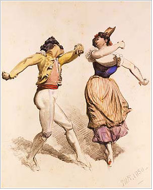Scene from El Fuego. Photo: Stefan Schweiger
Death, Dance and Salad (Muerte, Danza y Ensalada)
Music of the Spanish Renaissance courts
including a staged performance of Mateo Da Flecha’s ‘El Fuego’ or ‘La justa’
Performers: 4 singers, vihuela or lute, harp (6 in total)
This attractive programme brings together haunting laments, fiery dances and two ‘ensaladas’ – salads or mixtures of languages and foot-tapping rhythms, written as entertainments for the Valencian court.
 Da Flecha’s ‘El Fuego’ concerns the fire of sin which burns our hearts; the Holy Inquisition is called to put it out. Almost nothing is known about how these pieces were performed in the 1530s when they were written, so they have been staged for I Fagiolini by Peter Wilson MBE (who has also staged Handel’s Acis & Galatea, Purcell’s Indian Queen and a host of Renaissance dramas for I Fagiolini).
Da Flecha’s ‘El Fuego’ concerns the fire of sin which burns our hearts; the Holy Inquisition is called to put it out. Almost nothing is known about how these pieces were performed in the 1530s when they were written, so they have been staged for I Fagiolini by Peter Wilson MBE (who has also staged Handel’s Acis & Galatea, Purcell’s Indian Queen and a host of Renaissance dramas for I Fagiolini).
Another ensalada, ‘La Viuda’, describes the widowing of Spanish music because of the influx of Flemish musicians at the court of Charles V. The musicians call for the restoration of their privileges and employment.
 Spanish song from the 15th and 16th centuries reflected the mix of both strongly rooted traditions and more cosmopolitan cultures that flourished throughout the Iberian Peninsula as the result of politics, travel and trade. Burgundy and Italy were major influences while into this cultural melting-pot were injected elements of the Moorish heritage so firmly ingrained over the centuries.
Spanish song from the 15th and 16th centuries reflected the mix of both strongly rooted traditions and more cosmopolitan cultures that flourished throughout the Iberian Peninsula as the result of politics, travel and trade. Burgundy and Italy were major influences while into this cultural melting-pot were injected elements of the Moorish heritage so firmly ingrained over the centuries.
The Moorish theme is often present in the songs inspired by the reconquest of the kingdom of Granada in 1492. ‘Qu’es de ti, desconsolado?’ is full of wistful longing while shepherds argue boisterously in ‘Levanta Pascual’ before visiting Granada. Finally we hear from the Moorish king himself in the lament, ‘Una sañosa porfÃa’.
“For all the humour, the programme worked beautifully because of the deadly serious musicianship that is I Fagiolini’s gold standard. The juxtaposition of two versions of ‘Tres Morillas’ – one popular but anonymous, the other a more florid confection for court consumption – was illuminating, attuning the ear to the subtle graduations of harmonic colour and word-setting… Mateo da Flecha’s elaborate ensalada, ‘La Viuda,’ illustrated a wealth of aesthetic and historical associations; Bean salads rarely come as good as this.†The Guardian
- I was thinking that. Also @JolyonMaugham was (which carries a little more weight). https://t.co/pAu9emYdGd
- For my birthday I have done admin, walked dog, and rehearsed Walton with @The24choir https://t.co/jNTU2B3UIw https://t.co/LDhso8U9jS
- It's very reasonably priced and all those benefits.... https://t.co/DFJS8e9Dqw
